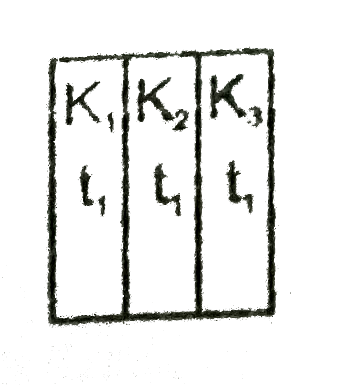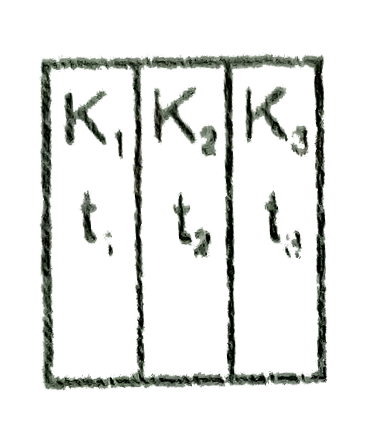Three slabs of same surface area but different conductivities k1,k2,k3 and different thickness t1,t2,t3 are placed in close contact. After steady state this combination behaves as a single slab. Find its effective thermal conductivity.

The correct Answer is:t1+t2+t3t1k1+t2k2+t3k3
 Req=R1+R2+R3 (series combination)
Req=R1+R2+R3 (series combination)
t1+t2+t3KeqA=t1K1A+t2K2A+t3K3A
t1+t2+t3Keq=t1K1+t2K2+t3K3
Keq=t1+t2+t3t1K1+t2K2+t3K3
Topper's Solved these Questions
- HEAT TRANSFERBook:RESONANCEChapter:HEAT TRANSFERExercise:Exercise-3
Explore 1 Video
- HEAT TRANSFERBook:RESONANCEChapter:HEAT TRANSFERExercise:Advancel Level Problems
Explore 17 Videos
- HEAT TRANSFERBook:RESONANCEChapter:HEAT TRANSFERExercise:Exercise-2
Explore 1 Video
- GRAVITATIONBook:RESONANCEChapter:GRAVITATIONExercise:Exercise
Explore 21 Videos
- KINEMATICSBook:RESONANCEChapter:KINEMATICSExercise:Exercise
Explore 65 Videos
Similar Questions
There slabs of thickness d1, d2, d3 and thermal conductivites λ1, λ2 and λ3 are placed in contact. Show that in the steady the combination behaves as a single slab of material of conductivity λ given by d1+d2+d3λ=d1λ1+d2λ2+d3λ3
View SolutionTwo walls of thicknes l1 and l2 and ther-mal condctivities K1 and K2 are in contact In the steady state, if the temperature at the outer faces are T1 and T2 find the temperature at the common wall .
View Solution
Knowledge Check
Two identical rods with different thermal conductivities k1 & k2 and different temperatures are first placed along length and then along area, then the ratio of rates of heat flow in both cases is
Ak1+k2k1+k2B4k1k2(k1+k2)2C(k1+k2)24k1D4k1k2(k1+k2)2Two metal plates of same area and thickness l1 and l2 are arranged in series If the thermal conductivities of the materials of the two plates are K1 and K2 The thermal conductivity of the combination is .
A2K1K2K1+K2BK1+K22CK1K2(l1+l2)K1l2+K2l2DK1+K2A cylinder of radius R made of a material of thermal conductivity K1 is surrounded by a cylindrical shell of inner radius R and outer radius 2R made of a material of thermal conductivity K2. The two ends of the combined system are maintained at two different temperatures. There is no loss of heat across the cylindrical surface and the system is in steady state. The effective thermal conductivity of the system is
AK1+K2BK1K2K1+K2CK1+3K24D3K1+K24
Define coefficient of thermal conductivity. Two metal slabs of same area of cross-section, thickness d1 and d2 having thermal conductivities K1 and K2 respectively are kept in contact. Deduce expression for equivalent thermal conductivity.
View Solutionk transparent slabs are arranged one over another. The refractive indices of the slabs are μ1,μ2,μ3,.............μk and the thicknesses are t1,t2,t3.............,tk . An object is seen through this combination with nearly perpendicular light. Find the equivalent refractive index of the system which will allow the image to be formed at the same place.
View SolutionThree rods of same dimension are joined in series having thermal conductivity k1 , k2 and k3. The equivalent thermal conductivity is
View SolutionSteady state temperature are shown in the diagram. Find ratio of thermal conductivity k1k2 if length of all rods are same

View SolutionCondider two rods of same length and different specific heats (s1,s2), thermal conductivities (K1,K2) and areas of cross-section (A1,A2) and both having temperatures (T1,T2) at their ends. If their rate of loss of heat due to conduction are equal, then
View Solution